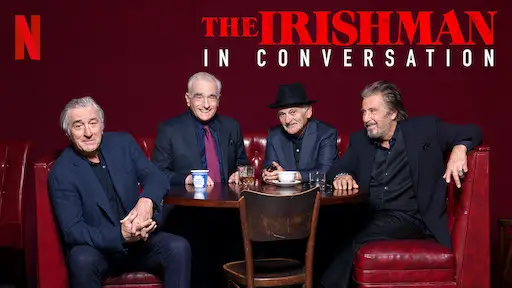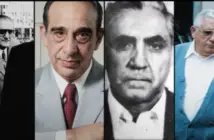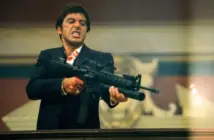Sure, at 209 minutes, the acclaimed Martin Scorsese movie “The Irishman” may clock in a bit long.
But the drama-filled moments skitter like gunfire throughout the film, so it would be a shame to skip it based on length alone. (Plus, it’s on Netflix, so you can make it a two-night event.)
Not only is the Mafia-themed film one of the best offerings currently running on the streaming service, but it may also offer a hint of truth about the disappearance of Jimmy Hoffa, the infamous head of the International Brotherhood of Teamsters with ties to organized crime.
Rumors have swirled around since Hoffa’s disappearance in 1975, including one that suggested that rather than being sent to sleep with the fishys in a body riddled with bullets, Hoffa’s remains were hidden beneath a concrete structure. Another had alleged crime figure Tony Zerilli of the Detroit Partnership, a subset of Cosa Nostra, attempted to lead authorities to Hoffa’s body after Zerilli said the union boss had been buried alive when a blow to the head from a shovel failed to do the job.
The stars come out for Scorsese epic
In the end, however, “The Irishman” may ultimately tell the true story.
In what is also one of Scorsese’s best films, “The Irishman” boasts an A-list of stars, including Robert DeNiro as Frank Sheeran, a WWII vet who finds himself entangled first in the underworld of the Scranton Mafia (sometimes known as the Northeastern Pennsylvania crime family), and later as a friend and bodyguard to Jimmy Hoffa, head of the International Brotherhood of Teamsters, himself with strong ties to the Mafia.
The relationship between the two began with Hoffa asking Sheeran, “I heard you paint houses,” which is Mafia code for carrying out hits, and the title of the George Brandt book “I Heard You Paint Houses: Frank ‘The Irishman’ Sheeran and the Closing of the Case on Jimmy Hoffa,” upon which the Scorsese film is based.
Al Pacino plays Hoffa as a demanding, petulant, stubborn man who ends up in prison, then ends up dead for overzealous attempts to regain his perch as the head of the Teamsters.
The movie is one that’s not only enlightening – if true, Jimmy Hoffa was cremated, along with all evidence of his shooting at the hands of his former bodyguard, Sheeran, and his remains will never be found – but also an edge-of-your-seat take of the secretive underworld lived by members of Italian-American crime families, along with the outsiders they allowed within those walls.

Al Pacino and Robert De Niro in The Irishman
A Teamster’s time unceremoniously ends
Hoffa’s role as the head of the Teamsters came to a halt when he was arrested in 1963 and indicted on charges of conspiracy, mail and wire fraud for misuse of the Teamsters’ pension fund, as well as jury tampering for an attempt to bridge a member of the grand jury.
While his sentence was commuted by President Richard Nixon in 1971, just a few years into a 13-year stint behind bars, his plans to regain the leadership of the union were not met with pleasure by some members of the Mafia, including former Hoffa associate Anthony Provenzano, a ranking member in the New York City Genovese crime family who became a sworn enemy of his former friend during a feud while the two were doing time at the same federal prison.
Anthony Giacalone, a kingpin in the Detroit Mafia, and his younger brother, Vito, attempted to mediate between Hoffa and Provenzano, who refused to help Hoffa regain his position as Teamsters’ head, but Hoffa’s son saw the meetings as a ruse to set Hoffa up for a hit. (This theory makes the story told by former Detroit Mafia member Tony Zerilli ring true.)
“Dad was pushing so hard to get back into the office, I was increasingly afraid that the mob would do something about it,” said James Hoffa in an interview with Arthur A. Sloane, author of the 1991 book “Hoffa.”
Is ‘The Irishman’ the true story of Hoffa’s demise?
On July 30, 1975, the day Hoffa disappeared, he believed he was meeting Provenzano and Giacalone, two mobsters from two different factions of the Cosa Nostra.
Sheeran was the driver and Hoffa’s supposed backup.
“Jimmy Hoffa had every reason to believe that Frank Sheeran, probably the toughest guy that anybody ever knew, was there to protect him in case of a problem and so Jimmy Hoffa got in the back seat of the car,” Brandt said in an interview with Fox News in 2004, a year after Sheeran died in a nursing home at the age of 83.
According to details in “The Irishman,” it might have been the plastic laid carefully out on the floor in the entryway to the home where Hoffa was expecting to meet Provenzano and Giacalone that gave away his precarious position or the lack of anyone there other than he and Sheeran, but as he attempted to leave, Sheeran shot Hoffa several times in the head.
Reportedly, his body was later rolled up along with the murder weapon and cremated, erasing most of the evidence, aside from drops of blood unearthed and sent for DNA testing in 2004.
That blood ultimately was not a match for Hoffa’s, and Sheeran’s story has since been disputed, but that’s what makes Hoffa’s disappearance and presumed death one of the most iconic mysteries of our time.
“The Irishman” is up for numerous Academy Awards including Best Picture, Best Supporting Actor nods for Pacino and Joe Pesci, who plays Russell Bufalino, head of the crime family and a character who in real life has been linked to the disappearance of Hoffa, and a Best Director nomination for Scorsese, among a handful of others.
But it is the reviews that make this time-hopping movie – called “a majestic mob epic with ice in its veins” by Owen Glieberman of Variety – so special.
“The Irishman” is set over a period of 60 years, including the three decades that Sheeran was a hitman for the Scranton Mafia, and 30 years later when he recounts his story from a nursing home wheelchair.”
You may also be interested in: The Irishman May Answer Hoffa Questions





